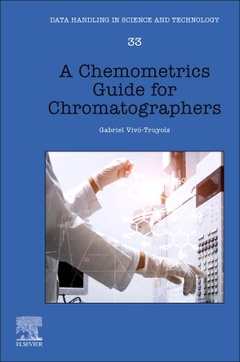Description
A Chemometrics Guide for Chromatographers
Data Handling in Science and Technology Series
Author: Vivo-Truyols Gabriel
Language: English
Subjects for A Chemometrics Guide for Chromatographers:
460 p. · 16.5x24 cm · Hardback
Description
/li>Contents
/li>Biography
/li>Comment
/li>
A Chemometrics Guide for Chromatographers, Volume 33 in the Data Handling in Science and Technology series, helps bring chemometrics and statistics to the chromatographic field, with the aim of making the statistical tools understandable and useful for this community. There are excellent textbooks about chemometrics and chromatography available on the market, but none are devoted solely to bringing both fields together in a simple language. The nature of the data arising from chromatography deserves special attention (e.g., data alignment, hyphenation or two-dimensional chromatography) and is thoroughly covered in this comprehensive resource, along with other specialized chapters.
Over recent decades, chemometricians have been busy developing algorithms and smart statistical techniques to (i) Optimize analytical instruments and (ii) Extract the maximum information out of the data generated by the instruments. It is no longer possible for separation scientists and chemometricians to work in isolation, as both spheres of knowledge must go hand-in-hand.
2. Introduction to chromatography
3. Chromatographic system optimisation (efficiency, time, and peak capacity optimisation)
4. Chromatographic selectivity optimisation (retention time optimisation)
5. Signal pre-processing in chromatography
6. Peak detection and quantitification of resolved peak
7. Peak fitting with single-channel detection
8. Peak resolution for multi-channel detection
9. Chemometrics and two-dimensional chromatography with single channel detection
10. Chemometrics and two-dimensional chromatography and multichannel detection
11. Fingerprinting and pattern recognition in chromatography
12. Appendix
- Bridges the gap between analytical chemistry and chemometrics
- Provides an overview of the data that arises from chromatography (i.e., data alignment, hyphenation or two-dimensional chromatography)
- Looks at how chemometrics can enhance chromatographic techniques
These books may interest you

Chemometrics in Excel 98.99 €



